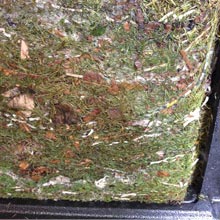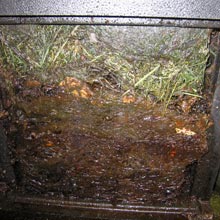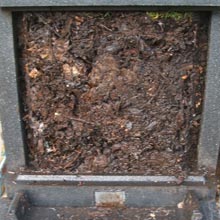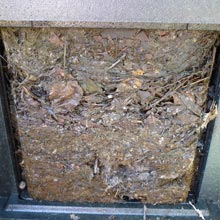What Does ‘Too Wet’ for Hot Composting Mean?
You have more water in the food waste than energy (calories/heat) available to evaporate the moisture as water vapour. If you do not balance a wet mix, the waste will not get above 40°c, it will turn smelly and a lot of liquid will drain from the base.
Is My Waste 'Too Wet' for Hot Composting?
It can be a challenge to find out. You are not looking at the waste to see if it 'dripping wet'. The waste is 'too wet' when the total percentage of water contained inside the waste cells is above 75%. As a rough rule of thumb:
- Garden waste has 40-60% water content
- Vegetable peelings have 70% water content
- Food waste is on average is 80% water content
- Foods like salads, juice pulp and cooked food have 90% water content
What Are the Signs My Waste is ‘Too Wet’ For Hot Composting?
- Lots of liquid fertilser (brown liquid) leaking from the mesh plate. (Check the water is definitely seeping from behind the mesh plate, ignore condensation and lots of water dripping off the inside of lid when you open it)
- The waste in the HOTBIN smells putrid, rancid or drain like (i.e. it is anaerobic)
- The temperature in the top layer will not increase above 30-40°c. (Poor aeration and a lack of new waste also prevents the temperature from rising above 40°c – so check these as well).
How Do I Fix (Balance) Waste That is 'Too Wet'?
- By adding dry ‘easy to digest’ waste into your mix. The easy and available material to add is shredded office paper/corrugated cardboard which helps absorb excess moisture. For information on shredded paper to wet/food waste ratios view how much paper do i need to add to food waste. (Avoid adding newspaper or cereal packet card for this task. They are not easy for bacteria to digest and will just end up as a mushy lump in your final compost.)
- Adding a bulking agent (woodchip). This should always be added with all waste to aid airflow within the HOTBIN. Remember: Shredded paper is to balance the moisture content in the waste and bulking agent is to maintain aeration. Both are essential to hot compost effectively and cannot be interchanged.
Step By Step Guide to Fixing a Wet HOTBIN
Step 1: Fix the Top Layer
Mix in 8 hands full (half a bucket or half a carrier bag) of corrugated cardboard (or shredded office paper). Check you have added at least 6 hands full of bulking agent (wood chip) to the food waste over past couple of weeks. If not, add now. Leave 48 hours. Check if temperature has risen above 40°C. If not, move to step (2) [Need help on bulking agent? See Below]
Step 2: Check the Base Layer
Take off the door panel and look at the waste in the base. Match how the waste ‘looks’ and ‘smells’ to one of the four options below. Follow the actions for your match. If you are unsure, send a photo to: help@hotbincomposting.com
| Option 2.1 | How It Looks | Next Steps To Follow |
|
Base layer Aerobic & active
Note: Your waste is still active. Typically this will be the case when the waste is less than 6 weeks old. |
 |
If the waste in the top does not rise above 40°C within 2-3 days, the base is probably suffering from restricted airflow. Mix in 1 to 2 carrier bags of paper into the base layer. Did you add at least a carrier bag of bulking agent during filling? If not, top up now. You may find it faster and easier to mix by emptying it out onto a plastic sheet, mixing then adding back. |
| Option 2.2 | How It Looks | Next Steps To Follow |
|
Base layer Anaerobic & active
Note: Your waste needs action to remove the smell and return to aerobic state. |
 |
Take out the base layer and leave on sheet of plastic to aerate and dry. (This may take a few hours). Mix in 1 to 2 carrier bags of paper with the base layer. Did you add at least a carrier bag of bulking agent during filling? If not, top up now. |
| Option 2.3 | How It Looks | Next Steps To Follow |
|
Base layer Aerobic, not active Is it mainly brown, sticky pieces, cold (below 20°C), very wet and soggy and claggy, no odour or an earthy odour. (Typically this will be the case with waste over 12 weeks old) Note: Your waste has composted and is now “stable”. It is unlikely to reheat to 60°C. |
 |
This is ready to take out and use. If you leave it longer it will compress further and eventually airflow will be severely restricted which will prevent the upper layer in the HOTBIN getting above 60°C. If you are worried the compost looks lumpy and too rough – please visit the post on ‘looks can be deceptive’. |
| Option 2.4 | How It Looks | Next Steps To Follow |
|
Base layer Anaerobic & inactive Is it black sludge, leaking water and has a pungent drain like odour. Note: Your waste has anaerobically composted. It is now “stable” and unlikely to reheat to 60°C. If you leave this waste in the base it will compress further and eventually airflow will be severely restricted which will prevent the upper layer in the HOTBIN getting above 60°C. |
 |
There are two options: a) Take it out and leave it to dry. Occasionally turning with a fork will help aerate the waste and remove residual odour. Once dried, break it up with a fork. Use the smaller bits as mulch, add the larger bits back into the HOTBIN gradually as a substitute bulking agent (it must be dry!) b) Dig it in to soil. (Before digging in – double check it is not active by looking at step 2.2. (Active waste will attract vermin and ‘rob’ soil of nitrogen due to ongoing bacterial activity). |
Still Struggling?
Get in touch! Send us a photo of your waste and we will provide some advice.




